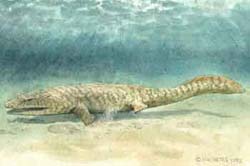Four-legged ancestor of land animals found in Europe

Water-color by Ahlberg (representing Elginerpeton from Scotland) showing roughly what a Devonian tetrapod might have looked like.
In the 19th century a fossil was uncovered in Belgium that was believed to be the jaw of a fish. Now a team of scientists have shown that it is in fact a fossil from an ancestor of all present-day land animals. It is the first discovery of a so-called tetrapod from the Devonian Period in continental Europe, which may trigger an interest in re-examining objects in museums.
In collaboration with researchers from France, England, and Belgium, Per Ahlberg, professor of evolutionary organism biology at Uppsala University, has demonstrated for the first time that four-legged fish, tetrapods, existed on the European continent during the Devonian Period (about 365 million years ago). These first land vertebrae became the ancestors of all present-day vertebrate amphibians, reptiles, birds, and mammals–and humans. The find also resembles the known “four-legged fish” Ichthyostega that was found by Swedish scientists in Greenland in the 1930s. Fossils of tetrapods from the Devonian Period are extremely rare. In recent years fragments have been found in the US, Scotland, Latvia, and China, among other places, but none of these bear any striking resemblance to Ichthyostega.
The fossil from Belgium is fragmentary (a portion of a lower jaw) but is interesting for several reasons:
- It is the first find of a Devonian tetrapod from continental Europe.
- The fossil is very similar to Ichthyostega, and it is the first sign that this type of four-legged fish existed outside Greenland. (During the Devonian Period Greenland and Belgium were closer to each other than at present, since there was no Atlantic Ocean, but the distance between the two areas was nevertheless at least 1,500 km.)
- Our increased knowledge makes it possible to identify terapod fossils that it was previously not possible to spot, not only in the field but also in old museum collections.
Today we have considerably more detailed anatomical knowledge about the earliest tetrapods than 20 or 100 years ago, which makes it possible to identify them even from tiny fragments, such as portions of a lower jaw. In the past it would have been necessary to have at least the better part of a skull (or the rest of the skeleton) in order to recognize a tetrapod. Methods for extracting the fossil from its enclosing stone have also advanced substantially. A new and extremely interesting technique is CT scanning, entailing a series of “x-ray sections” through a fossil, thus visualizing its three-dimensional structure even while it is fully embedded in stone.
Media Contact
All latest news from the category: Earth Sciences
Earth Sciences (also referred to as Geosciences), which deals with basic issues surrounding our planet, plays a vital role in the area of energy and raw materials supply.
Earth Sciences comprises subjects such as geology, geography, geological informatics, paleontology, mineralogy, petrography, crystallography, geophysics, geodesy, glaciology, cartography, photogrammetry, meteorology and seismology, early-warning systems, earthquake research and polar research.
Newest articles

Bringing bio-inspired robots to life
Nebraska researcher Eric Markvicka gets NSF CAREER Award to pursue manufacture of novel materials for soft robotics and stretchable electronics. Engineers are increasingly eager to develop robots that mimic the…

Bella moths use poison to attract mates
Scientists are closer to finding out how. Pyrrolizidine alkaloids are as bitter and toxic as they are hard to pronounce. They’re produced by several different types of plants and are…

AI tool creates ‘synthetic’ images of cells
…for enhanced microscopy analysis. Observing individual cells through microscopes can reveal a range of important cell biological phenomena that frequently play a role in human diseases, but the process of…





















